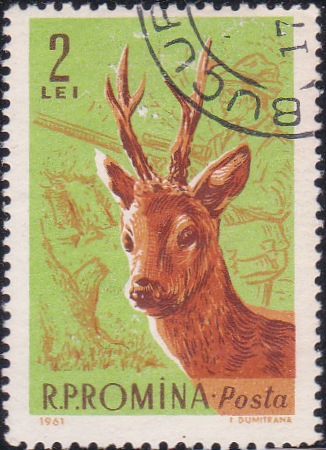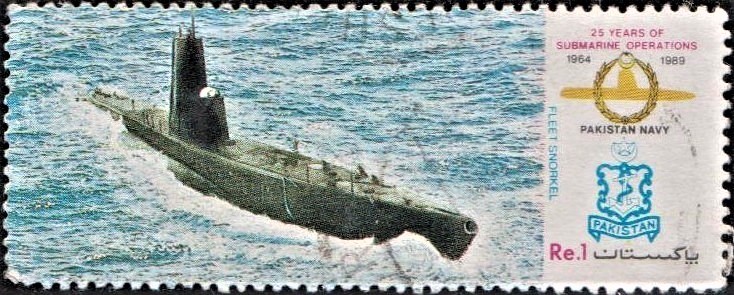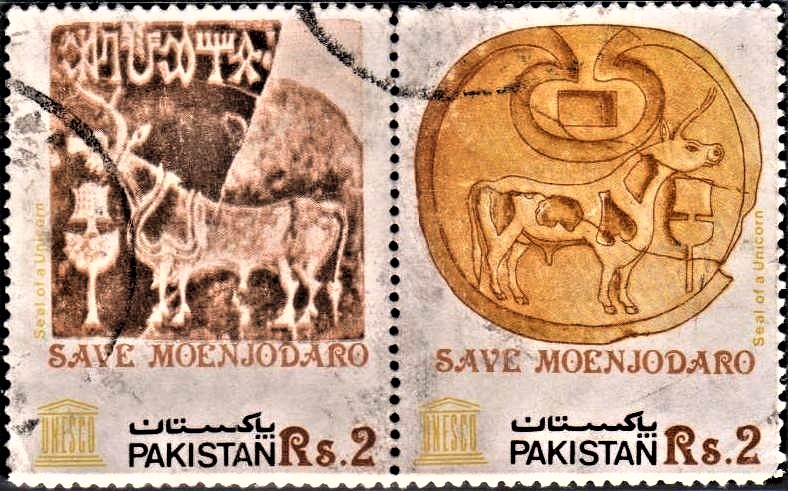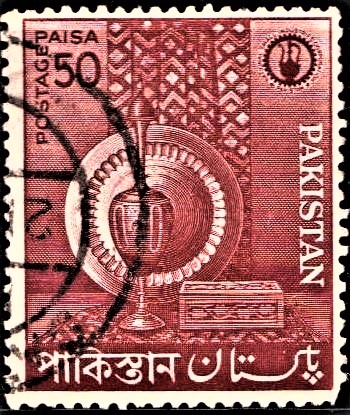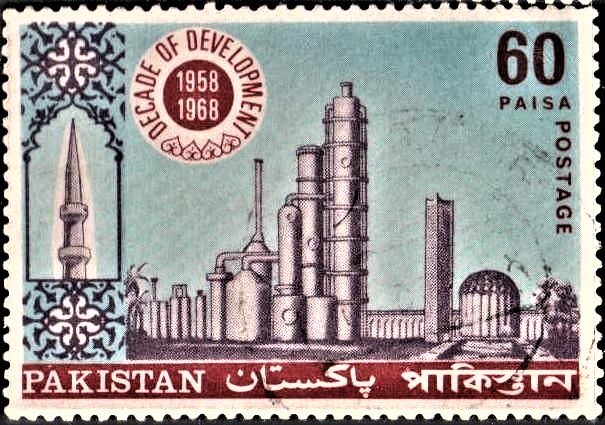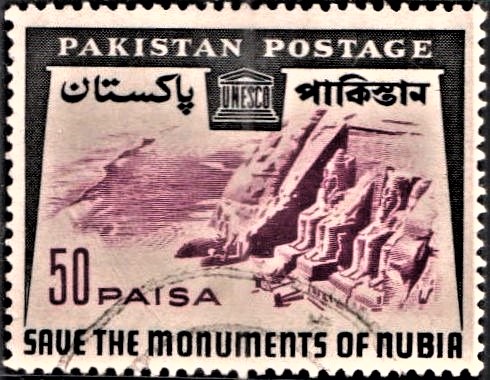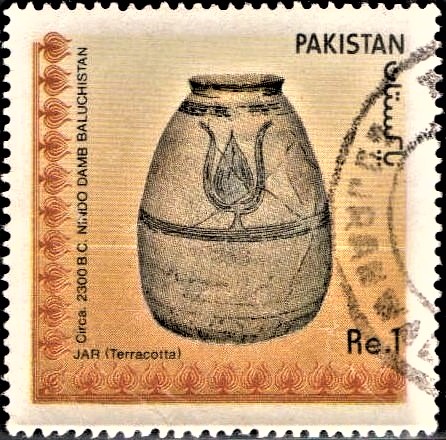
Terracotta Vessels from Balochistan
Complete set of 4 nos. of special postage stamp on the Archaeological Heritage of Pakistan (series) : Explorations and Excavations in the Baluchistan Province (7000 B.C. to 200 B.C.) :
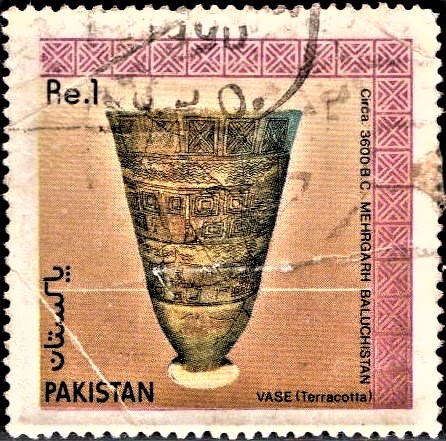
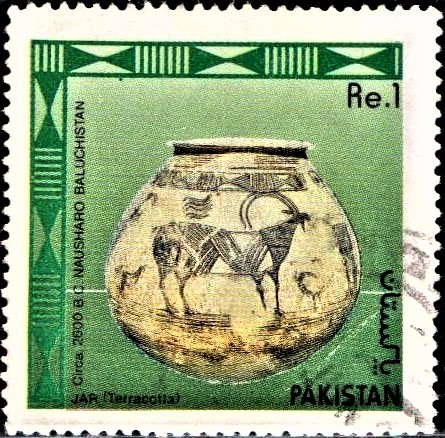
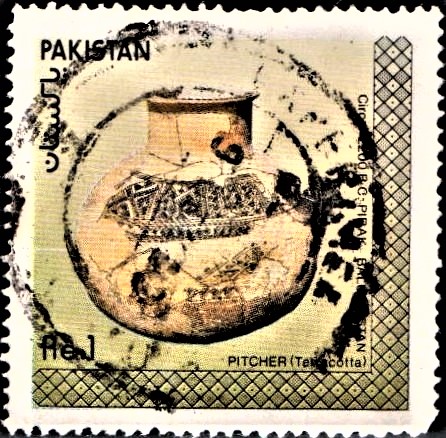
 Issued by Pakistan
Issued by Pakistan
Issued on Jun 28, 1989
Issued for : To focus world attention on the need to protect and preserve the most invaluable archaeological heritage of Pakistan, the Pakistan Post Office is issuing a set of four special postage stamps of Re. 1/- value each on the June 28, 1989.
Design :
VASE
Terracotta
Mehrgarh, Baluchistan
Circa. 3600 B.C.
Ht. 39 cm
A large vase with narrow bottom and open mouth with expanding sides, decorated in polychrome in five bands having geometrical designs on red slip surface.
JAR
Terracotta
Nausharo, Baluchistan
Circa. 2600 B.C.
Ht. 40 cm
A beautiful large jar having globular body and cut curved rim. It is decorated with geometric designs depicting long horned goats and birds.
PITCHER
Terracotta
Pirak, Baluchistan
Circa. 2200 B.C.
Ht. 28 cm
A hand made water pitcher with globular body, round base, straight neck, narrow mouth, cut projected rim, decorated in geometric designs in biochrome colours.
JAR
Terracotta
Nindo Damb, Baluchistan
Circa. 2300 B.C.
Ht. 32.5 cm
An elongated painted jar having short rim, narrow mouth and flat base. It is decorated with “pipal” leave and plant motifs. There are two black bands on the body of the jar.
Designer : Adil Salahuddin Chief Designer (PSPC)
Type : Stamps, Postal Used
Denomination : Re. 1/- each design
Colour : Multi Colour
Size of stamp : 36.77 x 36.77 mm
Size of print : 32.50 x 32.50 mm
Perforation : 14C
Quantity : One million each design (i.e. 4 million)
Number of Stamp in a Sheet : 60 (Sixty) (Se-Tenant)
Process of printing : Litho Offset
Printer : Pakistan Security Printing Corporation
About :
- MEHRGARH (Baluchistan)
(7000 B.C. to 800 B.C.)- The site of Mehrgarh situated in the north of the Karachi Plain at the foot of the Bolan Pass is about 150 Km from Quetta. Its geographical position is essentially one of transition between the upland valleys of the eastern Iranian plateau and the beginning of the plains of the Indus system.
- The site was discovered by the French Archaeological Mission in 1974. The excavations in subsequent years at the site have yielded a rich harvest of material dating from 7000 B.C. to 800 B.C. The study of the cemeteries unearthed in Mehrgarh indicates no sign of violence which further proves that the area of Baluchistan was an abode of peace. A number of skeletons bedecked with jewellery made of sea-shells and semi precious stones have been discovered. The people of Mehrgarh and its adjoining areas were civilized within every sense of the world. They had social contacts with the peoples of the plains of Euphrates and Tigris.
- The people of Mehrgarh were farmers and they harvested cotton, barley etc. as far back as 7000 B.C. They lived in houses where their pursuits were creative. During the early period, the art of pottery making was not known to the people of Mehrgarh and they used stone and bone tools. However, during the period 4000-2000 B.C. the pottery developed into a full scale industry. The painted greyware produced at Mehrgarh were exported to eastern Iran and Afghanistan. Besides, the beautiful pottery, their consummate skill in producing the male and female terracotta figurines was notable. The figurines were adorned with necklaces and complicated hair do, which may have some association with the religious system. The discovery of terracotta, stone, bone and ivory stamp seals attest to the development of an incipient administrative system.
- NAUSHARO (Baluchistan)
(3000 B.C. to 2000 B.C.)- The site of Nausharo in Karachi district, Baluchistan is located some 6 Km south of Mehrgarh. The excavations at this site were undertaken in 1985 by the French Archaeological Mission in collaboration with the Department of Archaeology, Government of Pakistan.
- The first occupation of Nausharo corresponds to the final period of Mehrgarh (3000-2500 B.C.) from where Faiz Mohammad grey ware, bracketed ware, Quetta ware and Wet ware were registered. The ceramic assemblage has similar characteristics to that found at Moenjodaro. The seals with unicorn and pictographs, figurines, pottery and architectural treasures discovered at Nausharo are typical of the Indus Civilization. It seems that the cultural links with Iran and Central Asia increased by the end of the occupation of Nausharo. It can be concluded that when the Indus Civilization in Sind and Punjab enters in its final stage, Baluchistan becomes an active component of a vast inter-cultural system extending over eastern Iran and Central Asia.
- NINDO DAMB (Baluchistan)
(2300 B.C.)- The chalcolithic site of Nindo Damb lies on the right bank of river “Kud” in Ornach valley in Tehsil Wadh, District Kalat.
- The excavations at this site were carried out by the French Archaeological Mission in collaboration with the Department of Archaeology, Government of Pakistan from 1962 to 1967. The excavations at Nindo Damb have yielded Kulli pottery alongwith terracotta figurines. Characteristic of this pottery is the animal pattern in landscape, painted around vases or without stands. Animals mostly bulls are represented with an elongated striped body and circular eyes. These are generally shown accompanied by birds, trees and foliage. Designs similar to those found on the Harappan pottery such as branches of pipal leaves and intersecting circles have also been found on red polished slip. As regards the terracotta figurines, they mostly represent a lady lavishly adorned with bangles and necklaces and they are shown in some case holding a baby in their arms. Such figurines are marked by an elaborate head dress with planted hair and sometimes a small cap. A few of these represent the typical Zhob style. Bull figurines are also numerous.
- PIRAK (Baluchistan)
(2500 B.C. to 800 B.C.)- The archaeological site of Pirak was first discovered in 1957 by R.L. Raikes. It is situated in the plains of Baluchistan on the western side of the road from Quetta to Jacobabad, about 12 miles south of Sibi. It is a low mound measuring about 300 x 200 metres. Its highest point is 8 metres from the level of the plain.
- Although the site was discovered by the said Hydrologist but the systematic excavations were carried out by the French Archaeological Mission in collaboration with the Department of Archaeology, Government of Pakistan from 1968 to 1974. During the course of the excavations, interesting biochrome painted pottery, a kind hitherto unknown in Pakistan has been found. It is hand made and the decoration consists of geometric patterns painted black or red brown with red filling on a buff background. It is interesting to note here that the designs painted on the Pirak pottery are similar on the motifs of Samarra ware of Mesopotamia. In addition to the pottery ware, many small blunt blades with carefully serrated edges, human and animal figurines, bone implements, terracotta and semi precious stone beads have also been found.
- The importance of this archaeological site can be well judges from the fact that it is the first excavated site in Pakistan which provides a passage from the Bronze age to the Iron age.
- (Contributed by Department of Archaeology, Exploration and Excavation Branch, Government of Pakistan).


